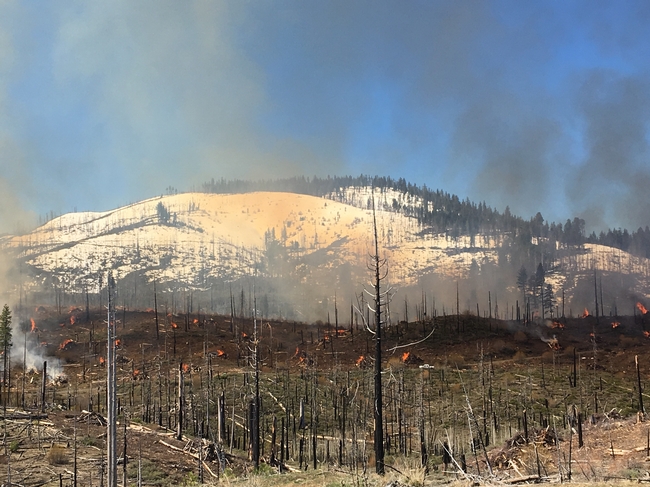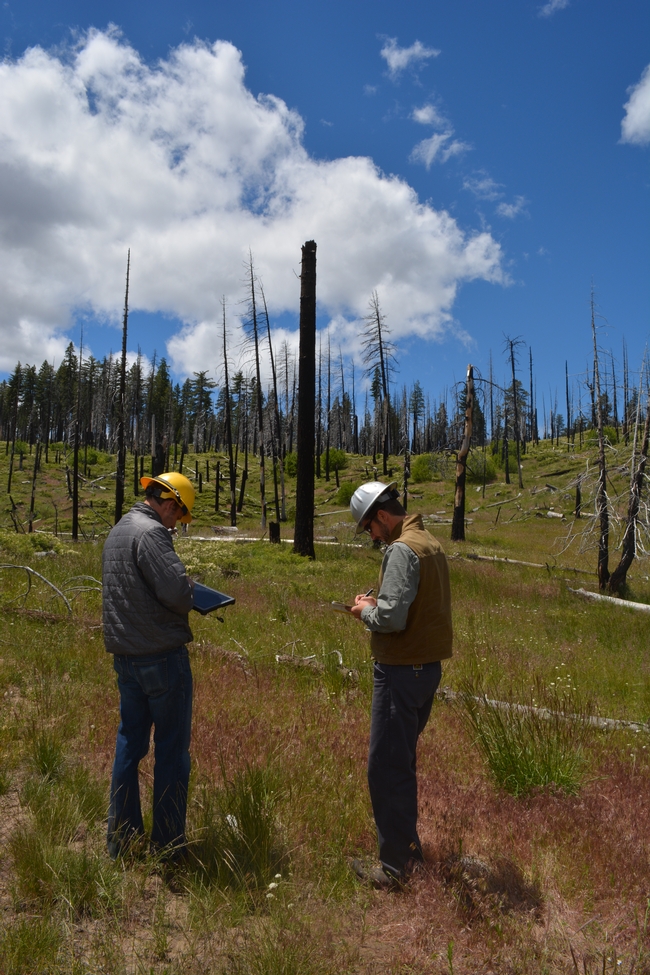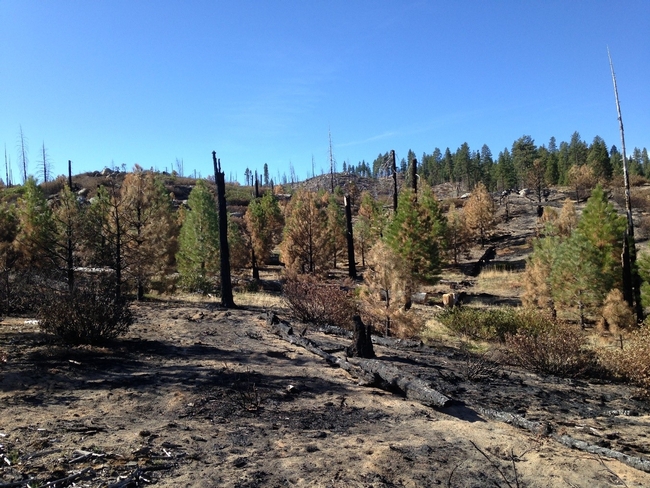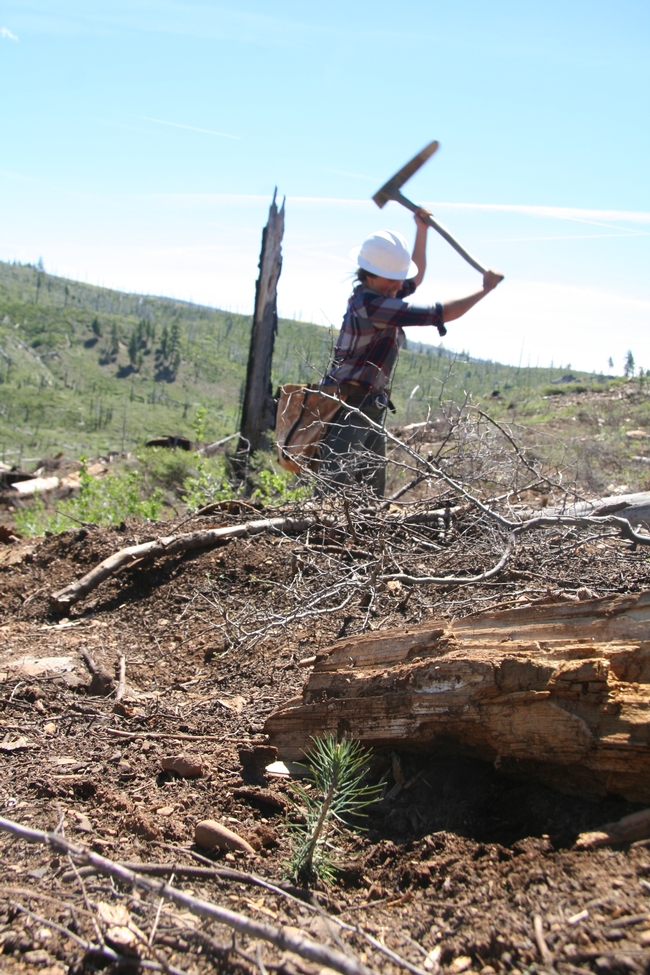Have you given your favorite tree a hug lately? Perhaps you would rather plant a tree? Well, on March 21, International Forest Day, Californians have a good excuse to do both.
In the first two decades of this new century, fire is having a transformative effect on California forests. Fires are burning with larger proportions of high severity and these high-severity patches are much larger, in many cases exponentially larger than would have occurred under natural fire regimes. This creates landscapes where all living trees – and potential seed sources for the next forest – have been killed. While fires can also have restorative effects and many species in California are adapted to fire, some species, like ponderosa pine, aren't adapted to these large, high-severity fire patches which alter the natural regeneration dynamics of the dry Sierran mixed conifer forests.
Across U.S. Forest Service lands in California, an average of 50,000 acres of forestland burned at high severity between the years 2000 and 2015; however, less than 30% of these acres were reforested on an average annual basis during this period. This creates a net cumulative loss of forest cover across public lands in the state.
To compound the complexity of this problem, there are growing instances of these large high-severity patches, burning again at high severity one to two decades later due to the homogeneity of vegetation and fuel profiles in the early seral stages after a fire. In 2013, the Rim Fire burned over 257,000 acres of largely mixed conifer forest, a notable portion of which had been replanted after the 1987 Stanislaus Complex Fire. Now foresters have to think: "Not only do we have to consider reforestation after a fire, but we must consider how we keep these young trees from burning up again!"
A common theme many ecologists agree on is that heterogeneous landscapes may be more resilient to fire – essentially breaking up the continuity of fuels and diversifying forest structure helps moderate fire behavior. However, over the past half century in California, we have tended to replant fires with a somewhat dense uniform square grid-spaced pattern of trees, which grow into a homogeneous carpet of new forest. As these trees grow, these dense plantations require maintenance – also referred to as “timber stand improvement” – activities to reduce competing shrub competition and “thin” the trees in order to maintain tree vigor and growth and reduce the fire hazard within the planted stand. Funding for timber stand improvement can wax and wane with the forest products market or federal budget priorities, and, on U.S. Forest Service lands, many of these plantations did not have follow-up treatment.
Seeing this problem brewing across the state, in 2005, a small sect of curious silviculturists and forest ecologists started asking some poignant question such as “Why do we spend money to plant trees which we will then spend time and money to remove a few years later – why don't we just plant less trees?” and “If heterogeneity is important for resilience, why do we always plant new trees in evenly spaced rows?” To many, this was, and still might be, heresy. But it begs a broader philosophical question that if we have diverse objectives for our forests, is it always appropriate to re-establish them in generally one uniform way? More importantly, given the latest fire trends, how can we promote heterogeneity and resilience to fire when we establish forests through planting?
I was one of these intrigued silviculturists. Linda Smith, culturist on the Plumas National Forest, and I started designing and planting low density, wide-spaced cluster plantations in 2007, after the 2006 Boulder Fire. The fire burned in a recreation area adjacent to a lake and part of our objective was to create a forest that would mimic a more naturally appearing structure, but we also knew this could be congruent with fire management objectives as well.
Ten years after the 2007 Moonlight Fire, much of the public lands were dominated by a homogenous fuel profile of flashy grasses, standing dead trees, a jack-strawed arrangement of fallen dead logs, and chest-high shrubs. While some of these stands had been planted, no site preparation or management of competing vegetation had been funded. We knew that any trees in this intermix would have a long haul competing against the shrubs, and in the meantime were exposed to high fuel-hazard each fire season.
Knowing something had to be done, the Plumas National Forest developed partnership agreements with the Sierra Nevada Conservancy and the Feather River Resource Conservation District to prepare the site, reforest and manage competing vegetation over approximately 3,000 acres. They also developed partnership agreements with Brandon Collins, a research scientist with both the U.S. Forest Service's Pacific Southwest Research Station and UC Berkeley Fire Science Laboratory, and Malcolm North, UC Davis associate professor of forest ecology, to monitor the success of different reforestation techniques at promoting heterogeneity and resilience to fire.
Through this partnership, we set up a replicated study to examine the effects of site preparation, planting, and competing vegetation treatments at promoting tree establishment and heterogeneity in young plantations.
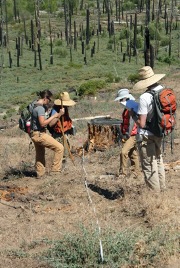
This spring will be the one year mark for the planted seedlings! There's still a bit longer to go before we're ready to reintroduce fire to the plantations, but we're on our way to that end goal.
In a sense, wildfire may have beat us out: Some of the wide-spaced cluster plantations that Linda and I planted in 2008 after the 2007 Antelope Fire burned 11 years later in the 2019 Walker Fire. I am pleased to see tree survival and some variable mortality. Looks like there will be some trees that deserve a hug this spring!
